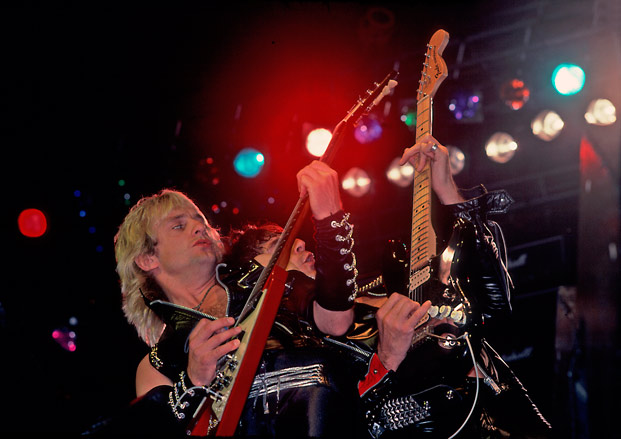A Bigger Guitar Sound: the Unspoken Truth

I was recently speaking to a friend, a drummer in a touring metal band. He said the band he plays for downsized its lineup from two guitarists to one.
They weren't sure how their sound was going to be affected, because (in theory) one few guitar would mean a weaker sound. Upon my friend’s recommendation to have the remaining guitarist play the metal parts with a bigger, more aggressive, "open rock" feel, the guys in the band realized things are actually sounding pretty good and have, so far, continued to tour as a four-piece.
Another truth of great guitar tone lies that example. I consider myself a full-on heavy metal guitarist. However, as I was growing up, I developed a taste for all kinds of rock and metal. I enjoyed everything from Whitesnake to Motley Crue to Fates Warning to Loudness to Judas Priest to Megadeth and Slayer. You get the idea. I was scrutinized in high school for that. as many might remember, if you liked "real" metal, you stuck to a particular band (and heavier). It didn’t matter to me; I thought that was stupid.
I never learned a boatload of songs while learning to play guitar, but one thing I definitely worked on is hearing the way the guitars sounded in a particular band. I quickly learned to distinguish how Mick Mars from the Crue “hits” the chords versus someone like Akira Takasaki from Loudness and how the band’s sound changes because of that. I learned how punk-inspired aggression works in a band like Slayer and how K.K Downing and Glenn Tipton let their early psychedelic-rock roots influence the sounds on the early Judas Priest albums.
My guitar riff bible comes from early Megadeth records where there was just enough precision and attack to make the riffs come alive. Those records really pulled in a nearly perfect mix of an early Priest-like sound and a pissed-off, frienzied, "machined" metal assault. I dug it. It was perfect. You were able to hear the notes, the overtones and the attack while you were allowed some air to enjoy it all.
It's a good idea to listen to bands that might not fit into the particular genre you might be into. As I said, I dug the uber-heavy down-tuned sludge of Carcass but also could appreciate the looser Aerosmith-inspired riffing of Tom Keiffer of Cinderella and took note of Dimebag Darrell’s surgical precision when it came to riffing. I suppose it's about being open to learn from others while you shape your sound. I believe the art of great guitar sound is slowly slipping away in heavy metal. The recording medium is partly to blame, as is the way guitars are edited. I don't hear the “aura” of guitars like I did on records of old.
You knew which band it was by the sound of the guitars. You knew “Some Heads Are Gonna Roll” was a Judas Priest song even before Rob Halford’s vocals came in. Did anyone question the identity of the band when they heard the riff and guitar tone in Pantera's “Walk”? Who knows, maybe our uncles felt the same about their music versus the stuff we grew up on (whichever generation that might be). It's important to listen how bands achieve sounds and how this information can ultimately shape your own tone.
Get The Pick Newsletter
All the latest guitar news, interviews, lessons, reviews, deals and more, direct to your inbox!
All great guitarists have been known to have a solid guitar sound and a particular way they play or attack the chords. Without getting too technical, you can play metal while injecting good movement in your picking hand to let the notes breathe. Many people try to copy Yngwie Malmsteen’s licks and sound, yet not many realize the space between the notes is where the answer might hide. I see guitarists just “play” chords and hear them come out on the other side through the speakers, but we can do better than that. I hope you can take a piece of what I've written above and see how it can work for you.
Polish-born Metal Mike Chlasciak has recorded or performed with heavy metal greats Rob Halford, Sebastian Bach, Bruce Dickinson and Axl Rose. Mike is the long-time guitarist for Judas Priest frontman Rob Halford's solo endeavor, Halford. Mike's new album, The Metalworker, is available at metalmike.net. For more info, check out his official website and visit him on Twitter.
"Upgrading from your entry-level acoustic opens the door to an entirely new world of tonewoods, body shapes, and brands": 6 signs it's time to upgrade from your first acoustic guitar
"I'm past my prime": 5 common excuses for not learning the guitar – and 5 body and mind-boosting reasons you should










